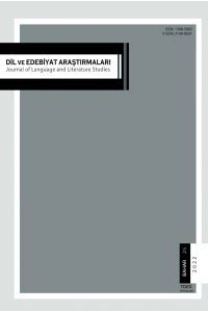Divan Şiirinden Hareketle Bir Sosyal Tipin Tespiti: Gedâ Örneği
Divan Şiiri, Nevâyî, Karakterizasyon, Çağatay, Timurlular, Sosyal Tip, Tip Karakter, Epitet
Extracting A Social Type From Divan Poetry: The Example Of The Geda
Divan poetry, Navā’ī, Characterization, Social type, Chagatai, Timurids, Type Character, Epithet,
___
- Abrams, Meyer Howard (1999), A Glossary of Literary Terms, Seventh Edition, Cornell University.
- Almog, Oz (1998), “The Problem of Social Type: A Review”, Electronic Journal of Sociology, Vol. 3: 1, pp. 1-34.
- Ali Şîr Nevâyî (2002), Dîvân: Bedâyiü’l-Vasat, (Prep.) Kaya Türkay, Ankara: TDK.
- Ali Şîr Nevâyî (1996), Dîvân: Fevâyidü’l-Kiber, (Prep.) Önal Kaya, Ankara: TDK.
- Ali Şîr Nevâyî (2003), Dîvân: Garâ’ibü’s-Sıgar, (Prep.) Günay Kut, Ankara: TDK.
- Ali Şîr Nevâyî (2006), Dîvân: Nevâdirü’ş-Şebâb, (Prep.) Metin Karaörs, Ankara: TDK.
- Anderson, Nels (1923), The Hobo, Chicago: University of Chicago Press.
- Baldick, Chris (2004), The Concise Oxford Dictionary of Literary Terms, Oxford: Oxford University Press.
- Bouvier, John (1856), A Law Dictionary, Adapted to the Constitution and Laws of the United States, Revised 6th Edition.
- Bustan of Sa’di (1488), “The beggar at the mosque”, a miniature signed by Behzâd, General Egyptian Book Organization, cairo, Adab Farsi 908, pl. LXX-B.
- Encyclopaedia Britannica, T. Editors of Encyclopaedia (1998, July 20), Herāt school. https://www.britannica.com/art/Herat-school Finestone, Harold (1957), “Cats, Kicks and Color”, Social Problems, Vol. 5, pp. 3-13.
- Foley, John Miles (1988), The Theory of Oral Composition: History and Methodology, Indiana University Press.
- Forster, Edward Morgan (2002), Aspects of the Novel, Rosetta Books. (First Edition 1927).
- Frye, Richard Nelson (1948), “Two Timurid Monuments in Herat”, Artibus Asiae, Vol. 11: 3, pp. 206-213.
- Gammell, C. P. W. (2017), The Pearl of Khorasan: A History of Herat, London.
- Günaydın, Alper (2017), Human Figures from the Dîvâns of Ali Shir Nevâ’î, Istanbul: Istanbul University, Research Institute of Turkology (Ph. D. Dissertation).
- Kaplan, Mehmet (1976), “Nabi ve Orta İnsan Tipi”, Türk Edebiyatı Üzerine Araştırmalar I, Dergâh Yayınları, pp. 214-234.
- Kaplan, Mehmet (1985), Tip Tahlilleri: Türk Edebiyatında Tipler, İstanbul: Dergâh Yayınları.
- Kia, Chad (2012), “Sufi orthopraxis: Visual language and verbal imagery in medieval Afghanistan”, Word & Image, Vol. 28: 1, pp. 1-18.
- Klapp, Orrin E. (1949), “The Fool as a Social Type”, American Journal of Sociology, Vol. 55, pp. 157-162.
- Masnavi-i Ma‘navi of Jalâl ad-Dîn Rûmî (1663), “A dog bites a blind beggar”, Walters manuscript, W.626, 82B.
- Nichols, Tom (2007), “Secular Charity, Sacred Poverty: Picturing The Poor in Renaissance Venice”, Art History, Vol. 30: 2, pp. 139-169.
- Niyâzi (2011), El-Lugâtu’n-Nevâʼiyye ve’l-istishâdâtu’l-Cağatâ’iyye, Nevâyî'nin sözleri ve Çağatayca tanıklar: Giriş, metin, dizinler, tıpkıbaskı. Edited by Mustafa S. Kaçalin, Ankara: Türk Dil Kurumu.
- Samizay, Rafi (1989), “Herat: Pearl of Khurasan”, Journal of the Islamic Environmental Design Research, Rome, Vol. 1: 2, pp. 86-93.
- Simmel, Georg (1964), “The Metropolis and Mental Life”, pp. 409-427, The Sociology of George Simmel, Wolff H. Kurt (ed.), New-York: The Free Press.
- Smith, John Thomas (2017), Lives of Famous London Beggar With Forty Portraits of the Most Remarkable. https://www.gutenberg.org/files/55285/55285-h/55285-h.htm
- Steingass, Francis Joseph (2005), A Comprehensive Persian-English Dictionaty, Including the Arabic Words and Phrases to be Met With In Persian Literature, İstanbul: Çağrı Yayınları. (First Edition 1892).
- Strong, Samuel M. (1943), “Social Types in a Minority Group: Formulation of a Method”, American Journal of Sociology, XLVIII, pp. 563-573.
- Subtelny, Maria Eva (1988), “Socioeconomic Bases of Cultural Patronage under the Later Timurids”, International Journal of Middle East Studies, Vol. 20: 4, pp. 479-505.
- Subtelny, Maria Eva (1991), “A Timurid Educational And Charitable Foundation: The Ikhlâṣiyya Complex Of ʿAlî Shîr Navâʾî In 15th-Century Herat And Its Endowment”, Journal of the American Oriental Society, Vol. 111 (1), pp. 38-61.
- The Smithfield Decretals, A patched tunic worn by a blind beggar, (British Library, Royal 10 E IV, fol. 110r), c. 1340.
- Uslu, Recep (1998), “Herat”, TDV İslam Ansiklopedisi, Istanbul, Vol. 17, pp. 215-218.
- Zorbaugh, Harvey Warren (1968), “The Dweller in Furnished Rooms: An Urban Type”, The Urban Community, edit. Ernest W. Burgess, New York: Greenwood Press. pp. 98-106. (Originally published in 1925).
- ISSN: 1308-5069
- Yayın Aralığı: 2
- Başlangıç: 2010
- Yayıncı: TÜRKİYE DİL VE EDEBİYAT DERNEĞİ
Skopos Kuramı Çerçevesinde Covid-19 ile İlgili Haber Metinleri Çevirisi Üzerine Bir İnceleme
Hokand Hanlığı’nın Meşruiyet Dayanakları Bağlamında Tüzükat ya da Vakıat-ı Emir Timur
Metinlerarasılık Kuramı Çerçevesinde Güngör Dilmen’in Deli Dumrul Adlı Oyunu
Roman Dillerinin Ortaya Çıkışına Kadar Latincenin Geçirdiği Evrim
Hissediş/İdrâk Fiillerinin Cümle Bağlamadaki Sentaktik ve Semantik Vazifeleri Üzerine
Hayretî Divanı’nın Yeni Neşri Bağlamında Eski Divanların Tekrar Çalışılması Üzerine
Herta Müller’in “Tilki Daha O Zaman Avcıydı” Adlı Romanında Totaliter Rejim
